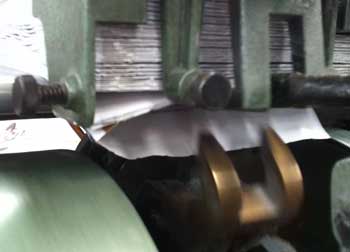 Here’s a simple bindery equipment troubleshooting video tip for both experienced and novice operators alike. Despite all my years running a variety of equipment, I used it just last week to overcome a problem on a Baum 714.
Here’s a simple bindery equipment troubleshooting video tip for both experienced and novice operators alike. Despite all my years running a variety of equipment, I used it just last week to overcome a problem on a Baum 714.
Like most good things, it’s a very simple concept—try slowing the machine to minimum speed. Or if the machine has one, use the “inch” or “jog” button. Then carefully watch the paper as it travels through the problem area.
Note: We’re not going to run at minimum speed, we’re simply going to troubleshoot. Slowing things down, especially on high-speed finishing equipment, can help us to isolate a problem and find a cure. Once we have a handle on the problem, we’ll resume normal production speed.
Paper usually leaves some clues about what is going on such as a bent corner, a wrinkle, a tear, scuff marks, and so on. Running in ‘slow motion’ can help you see what the problem is, or where it’s happening.
In this video example below, I show how ‘slow motion’ helped me isolate a problem I was having with creasing and folding on a Baum 714.
Slow motion can help your troubleshooting effort on any equipment…folders, scoring machines, saddle stitching and perfect binding lines, collators and more. Older style mechanical speed controls probably won’t allow you to slow down as much as you can with an electronic motor control, but it can still help.
Of course there are some common-sense things to be aware of:
- Some problems only happen at higher speeds. Machine speed changes how paper behaves, especially on folders. So your problem might disappear when you slow it down. Even so , the slow motion might give you some more clues to work with.
- With folders, it’s still a good practice to set up the machine at close to your expected running speed. Then if you run into problems, you can always slow it down to do troubleshooting.
- When using a jog or inch button, especially on inserters or gatherers, keep an eye on the whole line. Or have a helper do that for you. A sheet or signature can easily miss its registration point, causing a jam later on.
Slow motion—It’s a simple but effective technique as you’ll see in the video below. Do you solve problems by slowing things down? Feel free to share your stories below.


